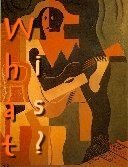| News Guides Performances What Is Music? | ELLOPOS | ||||
| ERNST BLOCH | |||||
| From: Ernst Bloch, Essays on the philosophy of music, tr. by P. Palmer | |||||
|
From the Arabic theory of music
(al-Farabi) had come the parable of the flowering tree whose branches were
finely proportioned by means of numbers, whose blossoms were the different
kinds of consonance and whose fruits were the dulcet harmonies (see Abert,
opus cit.). The universal tree is an age-old oriental simile, probably far
older than that of the planetary spheres, but it could be linked with the
Gothic trellis pattern that was now appearing in music. When the
mensuralist Marchettus of Padua uses it
around 1300, there is a connection with the art of
singing several differently measured notes in the upper part against one
note, i.e. the beginnings of the art of counterpoint. Music itself thus
became a richly sub-divided structure and a tree with many branches. But
this polyphony and its ramifications still did not abandon the astral
order: the polyrhythmic, polyphonic ground-bass included choirs of angels.
This was in spite of the completely new musical form and also in spite of
that scepticism about the harmony of the spheres which arose at the end of
the Middle Ages. An intended copying of musica mundana as being the
best music is found in the motets of Philip of Vitry, the contrapuntist we
have mentioned. Although
published as an Ars nova, i.e. an art giving free rein to the
native imagination, the melodies showed a strict uniformity and
periodicity and no changes of rhythm, in conscious 'imitation' of the
rotation of the stars. Such music had its theoretical basis in the
contemporaneous aforementioned Speculum musicae by Jacob of Liège,
a complete demonstration in notes of the universal hierarchy. The universality of music was
defended and scholastically classified. It now extended from the res
transcendentales et divinae to cover the whole cathedral of the
universe via stars, people, animals, plants and stones. And when the
hierarchical world-picture reflected in the heavens had shattered, the
harmonies of the spheres were still heard in art. There were still
'touches of sweet harmony', as Lorenzo described the stars to Jessica,
still these sublime lines of recollection: 'Die Sonne tönt
nach alter Weise / In Brudersphären
Wettgesang'.* And natural science, which deprived the world of these divine
attributes, was itself still deeply embedded in Pythagorean doctrine to
begin with. Even Kepler, one of the men who shattered the old image of the
world, adhered to the music of the spheres, and went so far as to describe
it in terms of the counterpoint of his age. With Kepler, the Lyra
Apollinis vel Solis became the Baroque orchestra with all its
polyphony. 'The celestial movements are
therefore nothing but a constant sounding together, ...all in a six-part
texture, as it were' (with the six planets as individual parts), 'and
organising and
interrupting infinite time with these notes. And so it is not surprising,
furthermore, that man, who copies his Creator, has gained an insight into
polyphonic song which was denied to the ancients, reproducing the constant
flux of world-history with a polyphonic musical structure of much artistry
in the brief fraction of one hour, and thus vicariously savouring the
Creator's delight in his work through the delicious feeling of bliss that
music, as it copies God, imparts to him' (Harmonices mundi V,
chapter 7). Finally, and as was to be expected,
Romantic natural philosophy gave a fresh boost to the ancient celestial
magic. This is most audible in Schelling. His Philosophy of Art again
sought 'to establish the supreme meaning of rhythm, harmony and melody' in
an astronomical fashion. In so doing Schelling associated rhythm and
homophonic melody, as possessed by the ancients, with the world of the
planets, but harmony and counterpoint, as an allegedly confused movement,
with the comets! This apart, however, his endeavour constitutes
a fresh revival of the astronomical theory of music in its entirety
-although, to be sure, it is already as foreign to the music ot the age as
it is
cosmic in construction. 'Heavenly bodies float on the wings
of harmony and rhythm; what has been called centripetal and centrifugal
force is nothing else than -this rhythm, that harmony. Lifted up by the
same wings, music floats in space in order to weave an audible universe
from the diaphanous body of sound and the note.' Item, the history of the harmony
of the spheres is still the history of the canonic system of the cosmos in
music and hence the history of the temple of Solomon in music, i.e.
the most highly conceived form-utopia. This form-utopia, of course, is
only utopian because distant in space. Its wish-dream applies to a
location which is not already present. Ideal time [Wunschzeit), and
consequently real utopia, infiltrates this changing harmony of the
spheres, the avowed harmonic-integrity of Creation, only inasmuch as one
conceives its ideal space [Wunschraum] as being filled not simply with the
music of angels but with that of a future Jerusalem. This occurs in
the earlier accounts of a -blissful end in which the departing person,
when well on his way, seemingly succeeds in hearing from the beyond a song
of the joy to come. The idea survives until far into the Baroque era in
the diverse references to musical miracles, as in the book Of the Three
Ages (1660) by Sperber, a Joachite and Rosicrucian: 'When, in 1596, a doorless chapel was
accidentally discovered in Jerusalem, people heard an agreeable harmony
like an angelic or celestial music coming from within. So they were in no
doubt that in a few years would commence the new age and joyful era when
they would constantly delight in hearing all that celestial music of which
earthly music is only the beginning.' Moreover we may recall, in a context
which is anything but heretical, the exclamation of Pius IV on hearing
Palestrina's Marcellus
Mass: 'Here a John in the earthly Jerusalem
is giving us an idea of that song which the holy Apostle John
once perceived in prophetic ecstasy in the heavenly Jerusalem.' There is an epigone's echo of this at
the end of Act 1 in Pfitzner's opera Palestrina, where he portrays the
creation of the Marcellus
Mass. Here, first one angel's voice, then several, and then angelic choirs
stretching to dizzying heights sing the music to the 'inspired' composer.
And Bruckner's majestic triads imply a background of heavenly sovereignty
still based in real faith; a burst of cherubic voices seems to be
reflected in the octave leap divided by a fifth which pervades his Te
Deum. To sum up, then: [...] above all: since Gregorian chant, music has been borne along by a
tendency towards moral order and -even without the myth of the spheres and
astral myth -a perfect harmony. Both historically and objectively, then,
music proves to be essentially a Christian art. Its harmony of the spheres
simultaneously disintegrates and reveals itself, becoming the source-sound
of self-shapings still unachieved in the world. * From Goethe's Faust, where archangel Raphael says: "The Sun intones, in ancient tourney / With brother-spheres, a rival song, / Fulfilling its predestined journey, / With march of thunder moves along. / Its aspect gives the angels power, / Though none can ever solve its ways; / The lofty works beyond us tower, / Sublime as on the first of days. " [Note by Ellopos]. Reference address of this text: https://www.ellopos.net/music/library/bloch.html"What is music?" home address: https://www.ellopos.net/music/library/ |
|||||
|
|
|||||

